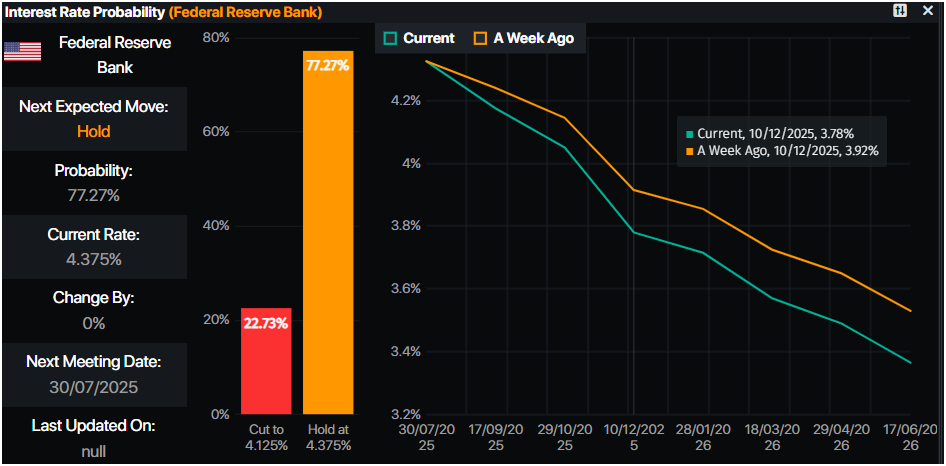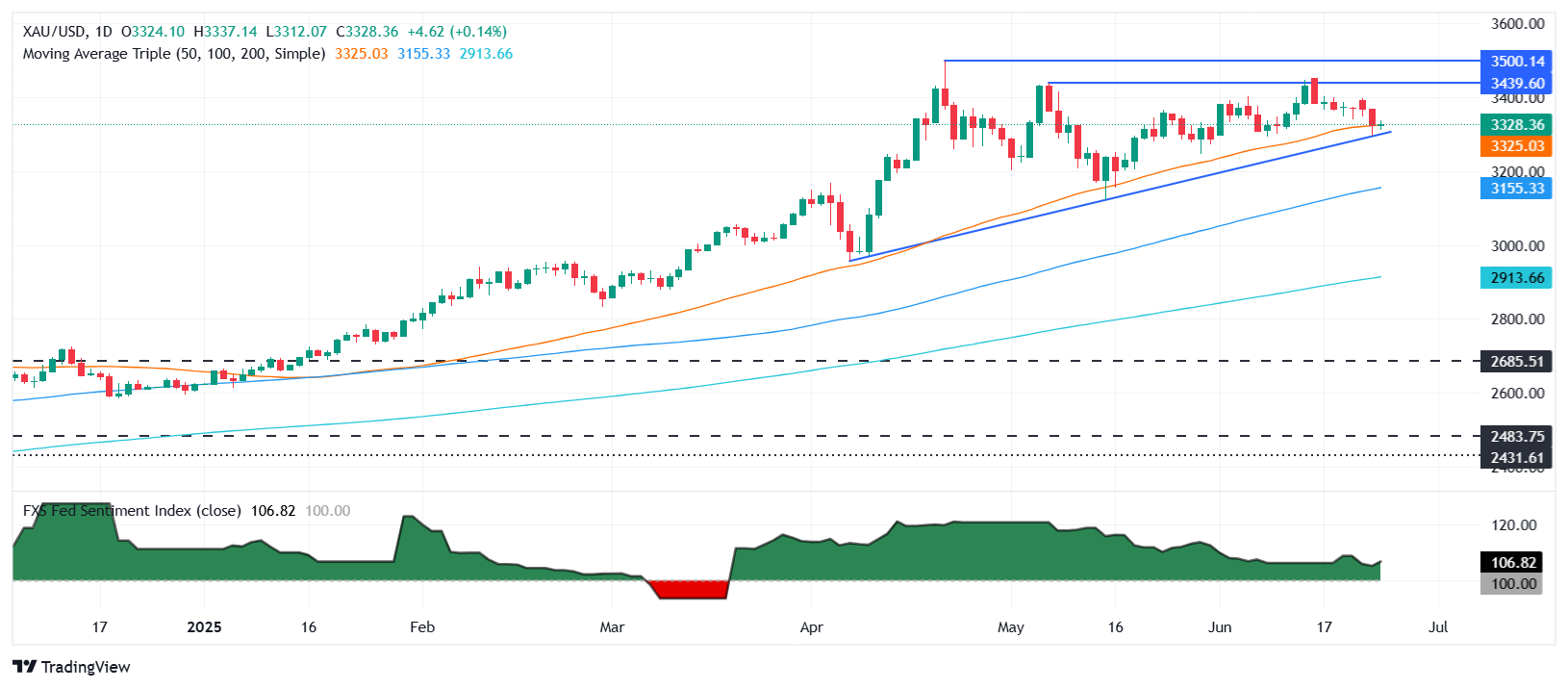- Gold is backed by weak data in the US housing market and a better mood on the market after the cessation of hostilities between Israel and Iran.
- Powell reiterates caution on tariffs and says that Fed must manage inflation risks despite relief signs.
- New housing sales fall 13.7% in May; The operators now focus on the data of durable goods and GDP.
Gold prices remain stable during the American session on Wednesday, rising more than 0.30% as it improves appetite due to risk due to the decalsed and truce of the Israel-Iran conflict. Housing data worse than expected in the United States (USA) could lead to actions by the Federal Reserve (FED). Even so, President Jerome Powell maintains his aggressive rhetoric, which limits precious metal profits.
The XAU/USD quotes $ 3,334, with an increase of 0.34% while the US dollar cuts some of its previous profits, while the shares in the US operate with profits.
The president of the FED, Jerome Powell, said during his testimony before the US Congress that tariffs could cause only a temporal increase in prices, but added that the risks of becoming persistent are sufficient for the Central Bank to maintain interest rates without changes.
“If it arrives quickly and ends, then yes, it is very likely that it is something punctual” that will not lead to more persistent inflation, Powell said. But “it is a risk that we feel. Like people who must maintain stable prices, we need to manage that risk. That is all we are doing.”
The president of the Boston Fed, Susan Collins, echoed Powell’s words, saying that the policy is appropriate, but open to lower rates cuts later this year.
As for the data, the sales of new homes in the US fell in May, due to higher mortgage rates about 7%. In the course of the week, the operators will be attentive to the publication of the requests for lasting goods, the figures of the Gross Domestic Product (GDP) and the reports of initial unemployment applications.
What moves the market today: the price of gold remains firm in the midst of a weak US dollar and the increase in yields in the USA.
- The price of gold stabilized after falling below $ 3,300, after the announcement of the US president, Donald Trump, on the cessation agreement of hostilities between Israel and Iran.
- The 10 -year Treasury bonus of the US pays 4.31%, uploading almost two basic points (PBS). The US dollar index (DXY), which tracks the value of the dollar value against a basket of six pairs, also falls 0.13% to 97.84.
- New housing sales in the US fell 13.7% in May, from 722,000 in April to 623,000. Analysts were waiting for a fall to 693,000 units. The high mortgage rates at 30 years, almost 7%, are the cause that consumers refrain from buying new houses.
- The precious metal is prepared to extend their profits, but sudden mixed data in the US limited their advance. Consumer confidence figures worse than expected, but preliminary PMI solids suggest that the economy remains solid, although it shows some signs of weakness. Next week, operators expect the publication of the figures from the Supply Management Institute (ISM) for June.
- Monetary markets suggest that operators are discounting 59 basic relief points towards the end of the year, according to Prime Market Terminal data.

Fountain: Prime Market Terminal
Xau/USD technical perspective: The price of gold collapses to $ 3,300
The price of gold is ready to consolidate near the range of 3,300 $ -3,340 $ for the rest of the day, in the middle of the lack of catalysts. The relative force index (RSI) is bassist, with upward trend and showing mixed readings, confirming the lateral trend.
In order for gold to resume its upward trend, buyers must push prices above $ 3,350 and $ 3,450. Once exceeded, the following resistance would be $ 3,450, followed by $ 3,500. On the contrary, if the Xau/USD falls below the simple mobile average (SMA) of 50 days at $ 3,317, $ 3,300 would be the first support level. Next, there is the minimum of May 29, $ 3,245 and $ 3,200.

FAQS GOLD
Gold has played a fundamental role in the history of mankind, since it has been widely used as a deposit of value and a half of exchange. At present, apart from its brightness and use for jewelry, precious metal is considered an active refuge, which means that it is considered a good investment in turbulent times. Gold is also considered a coverage against inflation and depreciation of currencies, since it does not depend on any specific issuer or government.
Central banks are the greatest gold holders. In their objective of supporting their currencies in turbulent times, central banks tend to diversify their reserves and buy gold to improve the perception of strength of the economy and currency. High gold reserves can be a source of trust for the solvency of a country. Central banks added 1,136 tons of gold worth 70,000 million to their reservations in 2022, according to data from the World Gold Council. It is the largest annual purchase since there are records. The central banks of emerging economies such as China, India and Türkiye are rapidly increasing their gold reserves.
Gold has a reverse correlation with the US dollar and US Treasury bonds, which are the main reserve and shelter assets. When the dollar depreciates, the price of gold tends to rise, which allows investors and central banks to diversify their assets in turbulent times. Gold is also inversely correlated with risk assets. A rebound in the stock market tends to weaken the price of gold, while mass sales in higher risk markets tend to favor precious metal.
The price of gold can move due to a wide range of factors. Geopolitical instability or fear of a deep recession can cause the price of gold to rise rapidly due to its condition of active refuge. As an asset without yield, the price of gold tends to rise when interest rates lower, while the money increases to the yellow metal. Even so, most movements depend on how the US dollar (USD) behaves, since the asset is quoted in dollars (Xau/USD). A strong dollar tends to keep the price of gold controlled, while a weakest dollar probably thrusts gold prices.
Source: Fx Street
I am Joshua Winder, a senior-level journalist and editor at World Stock Market. I specialize in covering news related to the stock market and economic trends. With more than 8 years of experience in this field, I have become an expert in financial reporting.







